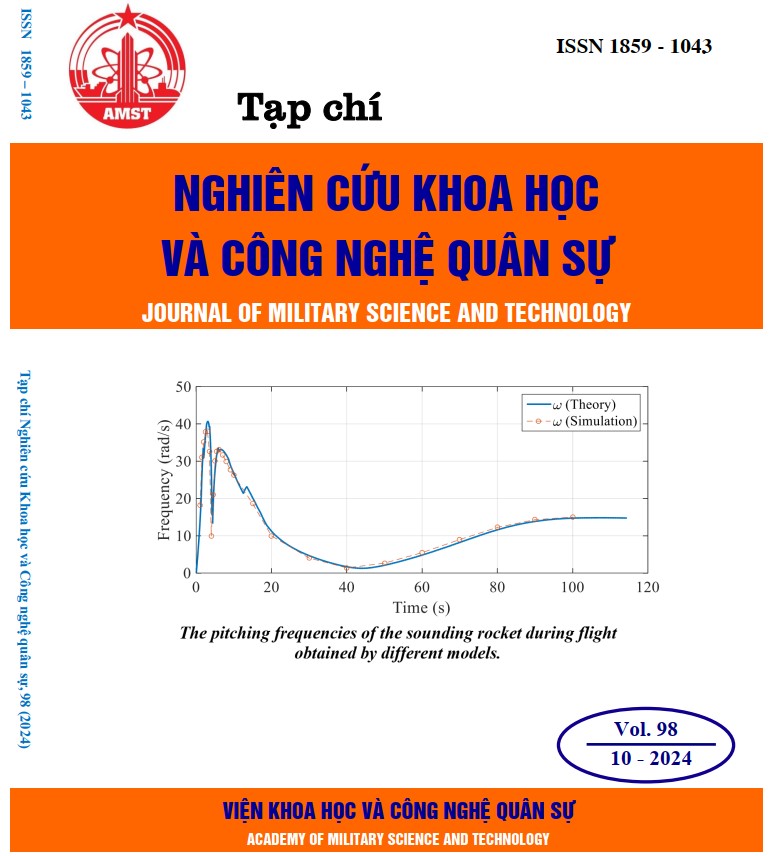Development of advanced biopolymer thin films of Carboxymethyl cellulose, Silver, and Zinc Oxide nanoparticles for avocado fruit preservation applications
512 viewsDOI:
https://doi.org/10.54939/1859-1043.j.mst.98.2024.124-131Keywords:
Carboxymethyl cellulose CMC; Ag nanoparticles; ZnO nanoparticles; Antibacterial; Fruit preservation.Abstract
Nanomaterials in post-harvest preservation offer advantages such as non-toxicity, chemical residue-free protection, and effective inhibition of mold and bacteria. Due to their strong antimicrobial properties and their ability to form a thin nano-coating on fruit surfaces, even small amounts of nanoparticles provide extensive coverage, preventing microbial penetration. This technology significantly improves fruit quality and longevity during storage and transportation. In this work, we introduced an advanced biopolymer film of carboxymethyl cellulose (CMC) incorporating ZnO and Ag nanoparticles (NPs). Ag NPs and ZnO NPs demonstrated an outstanding antimicrobial inhibition property that can be used for fruit preservation. As a proof of concept, the biopolymer thin films enable to extend avocado ripening from up to 35 days. The sugar concentration variation, the hardness, and the weight loss of the avocado with and without the advanced biopolymer thin film integrated ZnO and Ag nanoparticles in 35 days were compared with each other to clarify the ripening reduction ability of the biopolymer thin film.
References
[1]. D. S. B. Anugrah, H. Alexander, R. Pramitasari, D. Hudiyanti, and C. P. Sagita, “A Review of Polysaccharide-Zinc Oxide Nanocomposites as Safe Coating for Fruits Preservation,” Coatings, Vol. 10, No. 10, pp. 1–15, (2020). DOI: https://doi.org/10.3390/coatings10100988
[2]. Y. Amaregouda and K. Kamanna, “Carboxymethyl cellulose/starch-based films incorporating chitosan nanoparticles for multifunctional food packaging,” Cellulose, Vol. 31, No. 4, pp. 2413–2427, (2024). DOI: https://doi.org/10.1007/s10570-024-05753-8
[3]. B. J. Arroyo, A. C. Bezerra, L. L. Oliveira, S. J. Arroyo, E. A. de Melo, and A. M. P. Santos, “Antimicrobial active edible coating of alginate and chitosan add ZnO nanoparticles applied in guavas (Psidium guajava L.),” Food Chem, Vol. 309, p. 125566, (2020). DOI: https://doi.org/10.1016/j.foodchem.2019.125566
[4]. M. Koushesh Saba and R. Amini, “Nano-ZnO/carboxymethyl cellulose-based active coating impact on ready-to-use pomegranate during cold storage,” Food Chem, Vol. 232, pp. 721–726, (2017). DOI: https://doi.org/10.1016/j.foodchem.2017.04.076
[5]. T. M. P. Ngo, T. M. Q. Dang, T. X. Tran, and P. Rachtanapun, “Effects of Zinc Oxide Nanoparticles on the Properties of Pectin/Alginate Edible Films,” Int J Polym Sci, Vol. 2018, (2018). DOI: https://doi.org/10.1155/2018/5645797
[6]. S. Sharma et al., “Ecofriendly Fruit Switches: Graphene Oxide-Based Wrapper for Programmed Fruit Preservative Delivery to Extend Shelf Life,” ACS Appl Mater Interfaces, Vol. 10, No. 22, pp. 18478–18488, (2018). DOI: https://doi.org/10.1021/acsami.8b02048
[7]. B. Lin, Y. Luo, Z. Teng, B. Zhang, B. Zhou, and Q. Wang, “Development of silver/titanium dioxide/chitosan adipate nanocomposite as an antibacterial coating for fruit storage,” LWT - Food Science and Technology, Vol. 63, No. 2, pp. 1206–1213, (2015). DOI: https://doi.org/10.1016/j.lwt.2015.04.049
[8]. F. A. Al-Marhaby and R. Seoudi, “Preparation and Characterization of Silver Nanoparticles and Their Use in Catalytic Reduction of 4-Nitrophenol,” World Journal of Nano Science and Engineering, Vol. 06, No. 01, pp. 29–37, (2016). DOI: https://doi.org/10.4236/wjnse.2016.61003
[9]. Y. L. Zhang, Y. Yang, J. H. Zhao, R. Q. Tan, P. Cui, and W. J. Song, “Preparation of ZnO nanoparticles by a surfactant-assisted complex sol-gel method using zinc nitrate,” J Solgel Sci Technol, Vol. 51, No. 2, pp. 198–203, (2009). DOI: https://doi.org/10.1007/s10971-009-1959-5
[10]. D. Sodzel et al., “Continuous sensing of hydrogen peroxide and glucose via quenching of the UV and visible luminescence of ZnO nanoparticles,” Microchimica Acta, Vol. 182, No. 9-10, pp. 1819–1826, (2015). DOI: https://doi.org/10.1007/s00604-015-1493-9
[11]. H. Morkoç and Ü. Özgür, “General Properties of ZnO,” Zinc Oxide, pp. 1–76, (2009). DOI: https://doi.org/10.1002/9783527623945.ch1
[12]. S. R. Ghazali, K. KuBulat, M. I. N. Isa, A. S. Samsudin, and W. M. Khairul, “Contribution of Methyl Substituent on the Conductivity Properties and Behaviour of CMC-Alkoxy Thiourea Polymer Electrolyte,” Molecular Crystals and Liquid Crystals, Vol. 604, No. 1, pp. 126–141, (2014). DOI: https://doi.org/10.1080/15421406.2014.968058
[13]. S. Bashir et al., “In-vivo (Albino Mice) and in-vitro Assimilation and Toxicity of Zinc Oxide Nanoparticles in Food Materials,” Int J Nanomedicine, Vol. 17, (2022), pp. 4073–4085. DOI: https://doi.org/10.2147/IJN.S372343
[14]. V. Prasanna, T. N. Prabha, and R. N. Tharanathan, “Fruit ripening phenomena-an overview,” Crit Rev Food Sci Nutr, Vol. 47, No. 1, pp. 1–19, (2007). DOI: https://doi.org/10.1080/10408390600976841
[15]. O. B. Sogvar, M. Koushesh Saba, A. Emamifar, and R. Hallaj, “Influence of nano-ZnO on microbial growth, bioactive content and postharvest quality of strawberries during storage,” Innovative Food Science and Emerging Technologies, Vol. 35, pp. 168–176, (2016). DOI: https://doi.org/10.1016/j.ifset.2016.05.005
[16]. X. Meng, M. Zhang, and B. Adhikari, “The Effects of Ultrasound Treatment and Nano-zinc Oxide Coating on the Physiological Activities of Fresh-Cut Kiwifruit,” Food Bioproc Tech, Vol. 7, No. 1, pp. 126–132, (2014). DOI: https://doi.org/10.1007/s11947-013-1081-0







